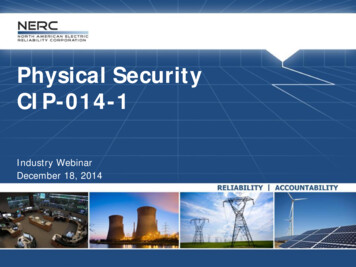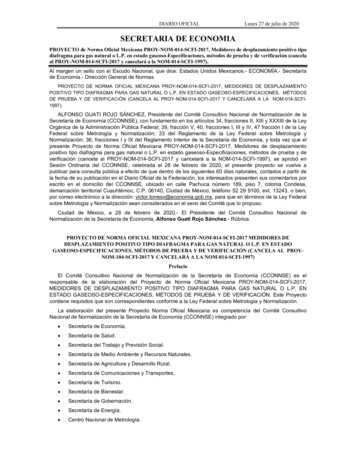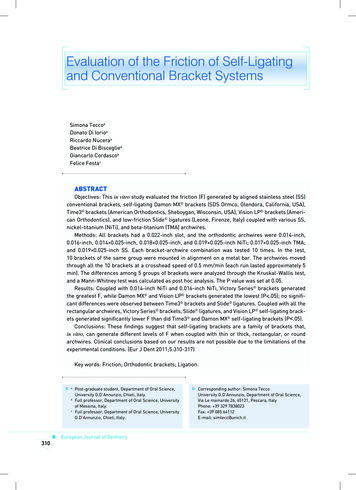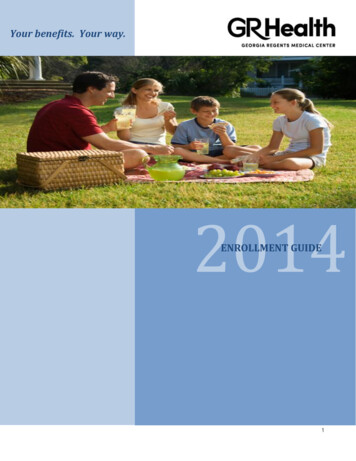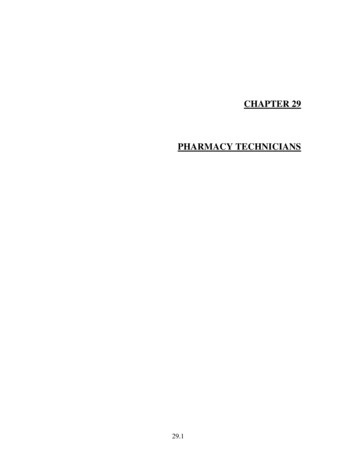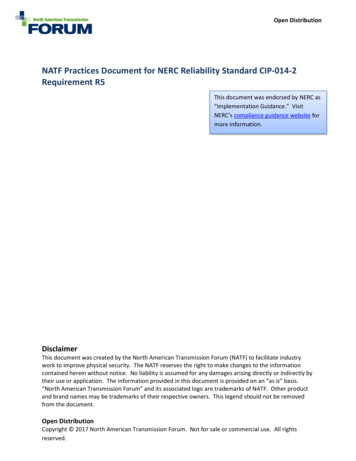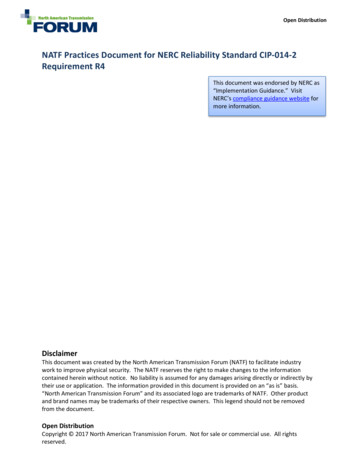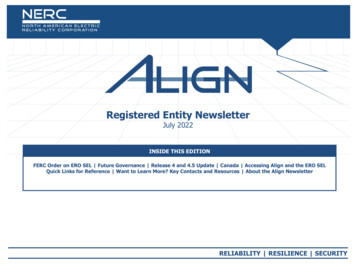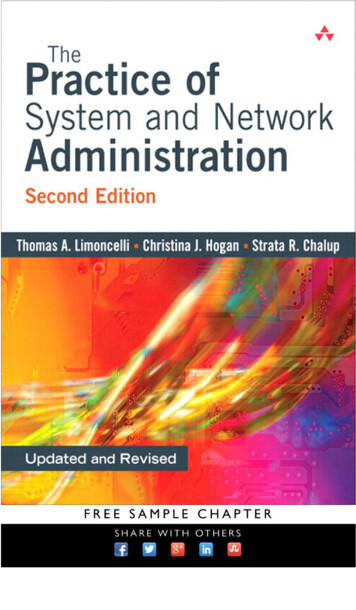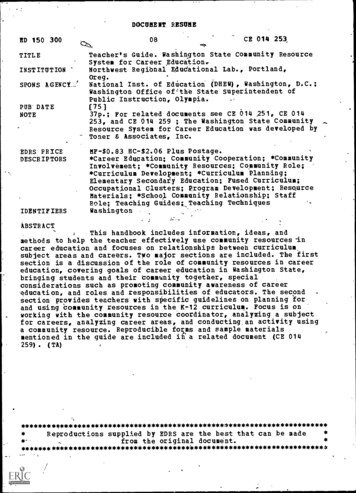
Transcription
DOCUMENT RESUMEED 150 300TITLEINSTITUTION'C,08CE 014 253Teacher's Guide. Washington State Community ResourceSystem for Career Education,Northwest Regibnal Edudational Lab., Portland,Oreg.SPONS AGENCY. .2PUB DATENOTEEDRS PRICEDESCRIPTORSIDENTIFIERSNational Inst. of EdUcation (DHEW) , Washington, D.C.;Washington Office of'the State Superintendent ofPublic instruction, Olympia.[75]37p.; For related documents see CE 614 251, CE 014253, and CE 014 259 ; The Washington State CommunityResource System for Career Education was developed byToner & Associates, Inc.MF- 0.83 HC-M2.06 Plus Postage.*Career Education; Community Cooperation; *CommunityInvolvement; *Community Resources; Community Role;*Curriculum Development; *Curriculum Planning;Elementary Secondary Education; Fused Curriculum;Occupational Clusters; Program Development; ResourceMaterials; *School Community Relationship; StaffRole; Teaching Guides;,, Teaching Techniques-WashingtonABSTRACTThis handbook includes information, ideas, andmethods to help the teacher effectively use community resources 'incareer education and focuses on relationships between curriculumsubject areas and careers. Two major sections are included. The firstsection is a discussion of the role of community resources in careereducation, covering goals of career education in Washington State,bringing students and their Community together, specialconsiderations such as promoting community awareness of careereducation, and roles and responsibilities of educators. The secondsection provides teachers with specific guidelines on planning forand using Community resources in the K-12 curriculum. Focus is onworking with the community resource coordinator, analyzing a subjectfor careers, analyzing career areas, and conducting an activity usinga community resource. Reproducible forms and sample materialsmentioned in the guide are included IS a related document (CE *********************************Reproductions supplied by EDRS are the best that can be madefrom the original *******************************
IIIeachers'Guide1U S. OEPARTME NT OF HEALTH,EDUCATION & WELFARENATIONAL INSTITUTE OFEDUCATIONTHIS DOCUMENT HAS BEEN REPRO.DUCED EXACTLY AS RECEIVED FROMTHE PERSON OR ORGANIZATION ORIGIN.ATING IT POINTS OF VIEW OR OPINIONSSTATED Di) NOT NECESSARILY REPRESENT OFFICIAL NATIONAL INSTITUTE OFEDUCATION POSITION OR POLICYWashington State Community Resource Systemfor Career Education,.Superintendent of Public instruction, Dr. Frank B. Broulliet,Old Capitol Building, Olympia, WA. 985042
tiSuperintendent of Public InstructionOR. FRANK 8 BROUILLETOLD CAPITOL SLOG, OLYMPIA. WASH. 98504The WASHINGTON STATE COMMUNITY RESOURCE SYSTEM FOR CAREER EDUCATION wasdeveloped in a special project for the Office of the Superintendent ofPublic Instruction, by Toner & Associates, Inc., Seattle, Washingtonwith the advice of the Community Support Task Force for Career EduCation.The GUIDE AND-MATERIALS developed for this system were produced by theNorthwest Regional Educational Laboratory, 710 S.W. Second, Portland,Oregon 97204 in cooperation with Toner & Associates, Inc.This work is submitted in confidence and has not yet been published. Therecipient receives the work in confidence and will use the same- only forthe purpose for which it is tendered.The work contained herein has been developed pursuant to a contract withthe National Institute of Education, U.S. Department of Health, Eddcationand Welfare. The opinions expressed in this publication do not necessarilyreflect the position or policy of the National Institute of Education,and no official endorsement by the Institute should be inferred.3
ContentspageTHE COMMUNITY RESOURCE SYSTEM FOR CAREER EDUCATIONOverview1Some Terms Used in This Guide40THE ROLE OF COMMUNITY RESOURCES IN CAREER EDUCATIONoals of Career Education in Washington State.Bringing Students and Their Community Together.7.10PSpecial Considerations13Roles and Responsibilities of Educators14TEACHERS' GUIDELINES--HOW TO PLAN FOR' AND USE COMMUNITYRESOURCES IN THE K-12 CURRICULUMWorking With the Community Resource Coordinator'19Subject Worksheets:20Analyzing a Subject for CareersAnalyzing Career Areas27Conducting an Activity Using a Community Resource4.
AtlThe Community Resource Systemfor Career EducationLTHE'WASHINGTON STATE COMMUNITY RESOURCE SYSTEM FOR CAREER EDUCATION is acompendium of materials including ideas, guidelines and Methods taat canassist any school or schobl district in planning and managing a systemfor involving working adults from the local community in career educationactivities for students in grades kindergarten through twelve. Itis.designed to be adaptable to existing programs.The individual(s) 'responsible for planning and coordinating the system,should receive a package of all the materials listed below, includingthis Teacher's Guide. Although teachers may not receive all theseThe materials include:materials, they should be familiar with them.ATHE COMMUNITY RESOURCE COORDINATOR'S GUIDEA handbook including suggestions, guidelines and techniquesfor use by the individual responsible for coordinating a localcommunity resource system from initial planning and organization'through implementation and evaluation.THE TEACHER'S GUIDEA handbook inclUding'information, ideas and methods to help theteacher effeftively utilize community resources in career educaThe focus is on relationships between curriculum subjecttion.areas and careers. Suggestions concerning activity preparationand responsibilities are included.THE EVERGREEN PAGESA statewide directory of information listing statewide resourcesthat may beTound in a local school district. Included are suggested formats for organizing a local directory and central fileof community, resources.SPECIAL MATERIALSA series of reproducible forms, samples and worksheets for useby the teacher and '.:Ommunity Resource Coordinator in developing,maintaining, using and evaluating the community resource system.COMMUNITY RESOURCE PERSON'S GUIDEA handbook designed to assist community persons to share theirresources and career knowledge and experiences with studentsat all grade levels.;A-
s.oPurpose of theTeacheOs GuideTeachers should be invollied in developing a local'commUhity resourcesystem, be fully aware of how this system is organized and know how toeffectively use these 'resources in their school's curriculum. This guideprovides teachers with an overview of the community resource system suggested in these materials and their role and responsibilities as part ofIt also offers guidelines and suggestions for analyzing careers init.various subject areas in preparation for using community resources.Although the idea of using community resources is not new and many schoolspresently are using them, this type of program presents some organizationalquestions for schools:Should each teacher spends time to identify and recruit localresources for his or her own use, or can this effort be coordin-'ated so that every teacher has quick access to a local listingor directory of recruited resources in a range of career areas?Do adults in the comaNty know what is expected of them whenworking with teachers and,students on a career activity?be provided with orientationHow can community resource peopand guidelines on how to talk wi 'students about their careerseither in schools or at their workp ces?How can teachers incorporate the use of community resources intotheir curriculum?What kinds of legal constraints exist in taking students intoworkplaces in the community?What kinds of special activities can teachers conduct with community resources?This Teachersis Guide addresses these-questions. Teachers should work closelywith their Community Resource Coordinator in applying the suggestions and information contained in this handbook as they work together to build a systemfor community resource use. Reproducible forms and sample materials are mentioned in this guide and are included in the Special Materials provided aspart of this system.6
aELEMENTS OF THE WASHINGTON.STATE COMMUNITY RESOURCE SYSTEM--The illustration shown below depicts the keyparticipants and activities within the systemand indicates by whom the individual materialsare intended to be used.Local School/CommunityTASK FORCEInformation/Orientation/EvaluationSCHOOL ORSCHOOL DISTRICTCOMMURITY RESOURCECOORDIgATORCRC GuideOSPI Support Materials1/Recruitment /OrientateEvaluationSpecial MaterialsTEACHERS K-12Evergreen Pagesfl COMMUNITY RESOURCESdommunity ResoicrcePerson's GuideSelected SpecialMaterialsTeach'er's GuideSeiected SpecialsMaterialsEvergreen PagesPLANNING & PREPARATIONICONDUCT ACTIVITY WITHCOMMUNITY RESOURCEIn School(a At Work Place3
SOME TERMS USED IN THIS GUIDE3CAREER EDUCATIONAn instructional strategy that blends traditionalschoolwork with activities from:She world of work.It begins with awareness of self,and careers inthe elementary years, continues with career explor.,ationn in the middle years and extends through thedecision-making and skill-developing stage in thehigh school years when one or more career specialties may be emphasized. ,(Key elements and outcomesoften depicted in career education plans are illustrated on'pageCOMMUNITY RESOURCECOORDINATORA person or persons designated by a school districtor districts whose responsibility is to develop andmaintain a community resource system that will helpteachers primarily throfigh identifying resources 400teachers On easilyoaccess. Duties may includerecruitment and. orientation of,resourcepersons,operation of the resource system, in-service trainingfor teachers and a variety of related tasks.COMMUNITY RESOURCEPERSONAny adult who is willing to volunteer time to shareinformation aid experiences about a given careerarea with students.FIELD TRIP'UsuLlly a student group tour of a workplace for thepurpose of seeing people perform work roles; emphasizing how school learning is applied in workingworld situations.,HANDS-ON EXPERIENCECarefully defined activities agreed on by communityresource persons and school staff that encouragestudents to practice a basic skill (like geometry)in a real world-of-work task (like sheet metal Alayout or space, vehicle trajectory) in a supervisedworkplace.IN-SCHOOL ACTIVITIES Formal and informal presentations by communityresource persons in the school for the purpose ofrelating world-of-work expertise to curriculum.Materials, films and equipment from the workplaceare often valuable aids that can be brought intothe school by the resource person.4
- (\t so'",JOB SHADOWINGY./.!career exploration activity' which4enablei-a stu'dent to spend one' or tore entire workdays with anadult on the job for, the purpose of observing manyaspects of that occupation during a typical daily.--cycle.VOCATIONAL EDUCATION Distinct from career education in that it stressesskill preparation for specific jobs not requiringa college degree, whereas; career.education encourages students to consider a broader (or the broadestpossible) range of occupational areas. Vocational-.education serves an important role in career education by. helping student's prepare for certain careersin well-defined Vocational- technical areas.WORKPLACE ACTIVITIES Include.field trips, job ,shadowing, hands-on experience--any off-campus learning activity where the,major purpose is t &help students see careers inaction and talk to those with experience and.experise in a given. occupation. In every'case, studentsare prepared with things to look for and questionsto ask.04. ;9514.
4ii/,;The Role. of Community Resourcesin Career Education!,./1"As a result of fhe process of education, all studentsshould be prepared for their next career steps."f---Goals for Washington Common Schools,Washington State Board of Education, 1972aXe' CAREER EDUCATION IN WASHINGTON STATEGO///,!IifCareer education is a direct response to students, parents, educatorsand the communify-a'-large who are concerned about the needs of peopleThrough direct experiencesij today's comp:ex work-oriented society.with adults and careers,-career education helps each student underdtanRe&pgihe values andlexlectations they wiil face in the adult world./nixing that a/pe son's satisfaction in a career relates directly o ppr/formance as a mniber of the community and as an individuil, career educetion in Washing on schools seeks to provide each student with the/attitudes,skills, knowle5ige.and self-awareness necessary tomake-successf4 c ceerchoices.!.,/iI)i/.f--NCareer education relies heavily on,the human and physical resources ofthe community to provide the real world experiences many students wantand need: Rather than adding something more to the curriculurk, careereducation offers a context of reality and usefulness within which coursebe present?.d:;!7/,/,-/00,7.,iv(i -.i---7
kHAT CAREER EDUCATION OFFERS STUDENTSThese Career EducationElementsCAREER AWARENESS--knowledge ofthe total spectrum of careers1.SELF -AWARENESS --knowledge of'2.These Career EducationOutcomesLead Tosm.410.1.fication with the world of work:options remain open fOr theindividual to move amongoccupations2.APPRECIATIONS, ATTITUDESlite3.DECISION-MAKING SKELS-,ipilying informatiOn to rationalprocesses to Teach decisionsSELF/SOCIAL FULFILLMENT -- activework ole; satisfying work role;responsibility as citizenroles; feeling4 toward self andothers in respect to societyS4'.SELF -IDENTITY --self -understanding;consistent value system; ability\to make decisions based onindividual valuespersonal aptitudes; interestsand ethical systemto.CAREER IDENTITY - -personal identi-4.CAREER DECISIONS - -career decisions;individual has a plan for careerdirection; bases decisions oninformation as distinct from-PfilitasyECONOMIC AWARENESS--perceptionof processes in production,S.-,-distribution and consumption61 SKILL AWARENESS AND BEGINNINGS. ,ECONOMIC UNDERSTANDING :-solvepersonal and social problems ofan economic environment; relateValues to compensation, security,.; growth and related economicmeasures6.employer expectations; 7.8.EMPLOYABILITY SKILLS--skillsin job-seeking, job-holding, jobadvancement7.EDUCATIONAL AWARENESS- -8.EDUCATIONAL IDENTITY - -abilityto select educational avenuesto develop career plans;decision-making as to postsecondary options, includingimmediate work, or furthereducation, or both. Awarenessof options for continuingeducation through Ldulthoodroles.78CAREER PLACEMENT -- eventualemployment in line with.careerdevelopment plan; affectivebehavior such as attitudes, coping,self-discipline, integrity areparallel attributes to thespecific skill or skillsperception of relationshipsbetween.educaticn and fifeAlEMPLMENT.SKILLS--varies fromunSophisticathd to verysophisticated skills dependingupon learnerCOMPETENCE - -familiarity with11
, The Washington State Community Resource Syitem is desi*ed.to lelp meet.Washington State's.goals and objectives for career education.One goalin particular relates to community resources--Item 4.2 of.the, k tate ofWashington Implementation Plan for Career Education:1."Fesources of the community, both human and material,will be used to expand the 4istricetcapacity fordelivering career education Co students."This goal was clarified by the Office of State Superintendent of PublicInstruction in the 1975 Washington Implementation Plan for Career Education.Dr. Frank B. Brouillet, Superintendent of Public Instruction, and theState Career Educaticn Advisory Committee issped the following statementssupporting the use of community resources and community involvement inimplementing career education in Washington. schools:The Superintendent of Public Instruction (SPI) encourages thedevelopment and upgrading of career education programs at thelocal school district level by providing services and assistancethat.will:I.II.Promote program planning and support, including:1.the establishment of local district board commitmentto career education2.the development of sound career education managementsystems3.staff development of teachers, administrators, guidanceworkers and other special support personnel4.community support for career education programs5.the support of business, industry and labor forcareer education programs.Promote the development and utilizaiion of alternate careereducation delivery systems within the following classifications.1.classroogLdnstructional fervice----Classroom instructional resourcesIII.3.occupational information guidance services4.self-assessment guidanCe services5.colpunity resources.Promote the development anti utilization or systems forevaluating career education programs, including:1.measurement of program impact on student growth2.review of procedural methods.1 r)I9
.0vt.0BRINGING STUDENTS A'ND THE COMMUNITY TOGETHER.What is a- Community Resource?A community resource for career education can be a person in your communitywilling to volunteer a smaqlamouneof time, the actual workplace of thatperson and the materials and equipment that person uses to do his or herCommunig people, workplaces, materials and equipment help studentsjob:become aware of many different career choices available to them and seefirst -hand how things learned in school are applieid in the working world.These.' are special,resources,that,canntat be offered by any single-teacheror provided inside-the,school.,Using Community Resources in Career-Education ActivitiesThere are two basic ways that commupity'resOurces maybe used to helpstudents-learn: Working people from the community 'nay be invited to,4i.come nto the cladbroom or school and talk to students about their work,Or students may visit workplaceS in their community to learn directlyfrom people engaged'in various occupations.Many people in your community will'be willingto volunteer sometime to come into your school and participate in adiscUssion with students'about their careers., They may, for example,.In- School Activities.giye a presentation to one group. of students or i56 involved 'in.panelMany, - community 'resourcediscussions, seminars and career-day activities.:f50*1.-6-aite-&la-1.6-)E64iililralong sample produCts, materials or.light,ment-they use in their jobs. With a-little assistance-and coordinationfrom teachers, they can relate the particular skills they use in theirjobs:to the individual academic subjects (English, math, etc.): Theycan'talk about their own education and training and how they got intothe job they presently have. The Community Resource Person- s Guide isdesigned to help these resource people prepare an interesting presentationof this guide,fOr students. Teachers should be familiar with the, contentstoTell Them.",particularly the section, "Your Student Audience and WhatWorkplace Activities. There are two general types of activities forstudents vj,giting a community resource: field trips or student toursof a-workplace (in groups or individually), and career'explorationactivities, which include student-conducted interviews with and observations of working people, "job shadoWings,loy an individual student and"hands-on" workplace-experience.13'
--e--Field-trips-or student tours are planned visits to- any sitein the community where people are gainfully employed orengaged in meaningful work. The specific educational purposeis to let students see firSt-hand what people do for a livingand how they do it. The secret of successful field tripsand tours is in careful advance planning between teachersand community resource people sb both know each other'sexpectations and desired outcomes for the students.Career explorations are for individual students or small.groups, generally at the middle or high school levels.The purpose is.to-help students prepare for their nextcareer rteps--career decisions and skill development. Studentsmight spend:one-or more days touring the workplace, takingphotographs, interviewing employees in generall, documenting'specific occupations and the people,- equipment, resourcesand products that are Part of these occupations.A "jOb shadowing" situation is one in which an individualstudent might be with a community resource person for oneor more full working days. Job .shadowing activities Shouldbe carefully planned in advance with employers and; whenappropriate, union representatives aea site to eliminateany possible questions or concerns before a student beginsthe activity."Hands-on" experience gives students specific tasks toperform at the workplace as part of a career exploration.The emphasis is educational, however; students do not assumean employee role. The purpose of the experience is to givestudents a practical basis for making actual career decisions."Hands-on" activities at the workplace are also used todemonstrate how academic skills are applied in daily worktasks.,Various-other school-sponsored programs, including work-study and cooperativeeducation, provide "hands-on" workplace experiences. For these educational*experiences, students may receive school credit, pay or a combination of payand credit. Specific learning activities must'be agreecfon and all legal andeducational requirements met before a student arrives at a site for thesekinds of experiences.Legal ConsAdirationslor Workplace Activities Legal implications for "hands-on" activities require special consideration.Activities that give students "hands7on" experience -- particularly inpotentially hazardous, situations- -must meet specific child labor provisionsYou should be familiar with thoseof the Fair Lahbr Standards Act.provisions (see, next page).1411
All "hands-on" activities at workplaces need to be cleared with yourdistrict vocational education director or other designated person. Ifyou have any questions about particular workplace activities, contact theU.S. Department of Labor, the Washington State Department of Labor andIndustries or, when appropriate, labor union locals in your area forclarification. Community resource people will be counting on you, as theirschool contact, to know what student workplace activities are possible.WHAT ARE THE LEGAL LIMITS FOR THE KINDS OF "HANDS-ON" WORKPLACETASKS A STUDENT CAN DO?Students may be involved in occupations defined as hazardous if thefollowing conditions -are properly met:*1.the terms of the involvement are spelled out in a writtenagreement, signed by the employer and school coordinatoror principal2.the involvement is incidental to the student-learner'straining3.the involvement is intermittent, for short periods of timeand under the direct and close supervision of a qualified,experienced person4.safety instructions are given by aid schoOl and correlated"by the employer with on-the-job training5:a schedule has been prepared'Of organited and progressivework processes to be performed on the jtib4*See "Hazardous Occupations," Exemption II, page 9 of,A-Guide to,-Chi1dLabor,krovisions of the Fair Labor Standards Act,hijd Labop/EulletinNo.' 101 (revised), 1971. Superintendent of Documents; U. eGovernMent Printing Office, Washington, DtC. 20402 (200)./"'WHO ASSUMES RESPONSIBILITY FOR STUDENTS AT-THE ,WORKPLACE?School distr4cts already involving students inc.caree'i educationexperiene654n the community may find thWtbeil, existing district-,liability policies protect both participating employers and thestudents engaged in learning activities in the community. Districtsare usually liable for student actions and behavior at communitysites, but you should verify your district's own provisions foremployer and student protection.''Personal injury protection for students may be provided either bythe student's own medical and accident coverage as verified byparents or by the district's coverage for students participatingin school-related work situations':1215A
LLSPECIAL CONSIDERATIONSExperience in career education has shown .that there are three major areasof community/school interaction needing constant attention:promoting awareness and understanding of the need for careereducation among citizens in the community'providing volunteer community resource people with an easy processor system to help them structure their involvementunderstanding legal constraints that some community resource peopleface (e.g., labor practices and work laws) in providing careerexperiences for students.Teachers can help avoid Problems in these areas by considering the ideasin this guidebook.Pivmoting.Community Awareness and Understanding of Career EducationCommunity awareness can start with, the resource recruitment survey yourdistrict may have already conducted. Teachers should also be involved ona task force comprised of school and community members which will helpdevelop and maintain the program. Every available opportunity should be,used to explain the purposes of career education and-how world-of-workresources can help.Providing Community Resource People With an Easy ProcessCommunity resource people need to understand what their role should be -what kinds of interaction with students are desired and expected.Theyneed to be protected from unreasonable demands made through oversight orlack of coordination.,.They need support and encouragement in what, for many of them, is a newexperience.The Community Resource Person's Guide provides both a generalintroduction to career education and a guide to working with students bothin classroom visits and at workplaces.There are detailed Suggestions for(This guide is alsohow to talk about careers with students of all ages.must reading for teachers.)Promgting Teacher Sensitivity to Community ConstraintsResource people occasionally operate under constraints which teachers maynot-Understand. Teachers should be aware, for instance, that labor unionrepresentatives and shop stewards should be directly involved in planningstudent experiences at union shops. All resource people operate under time;;',/kcOnstraints which the teacher and students need to respect.%The)Communi y Resource Person's Guide will provide teachers with many sugges ons o how to deal sensitively with the community.11316
.-)ROLES AND RESPONSIBILITIES OF EDUCATORSInitiating a system for community resource use requires a partnershipapproach from the very beginning The system will need active supportfrom the community, the school board, the school administration, theteachers and the students. -.The outlines. of the roles which follow suggest examples cf functions these individoals.and groups can/might.per.form.The Role of the, School BoardsSchool AdministrationIt is very important, in building ,a coordinated effort utilizing resources,to have the firm support of the school board and'both school and district,administration. School boards represent the community's involvement inevery dimension of education: They establiSh policies, and give assistancethat is'responsible to both school and community interests.TYPICAL SCHOOL BOARD RESPONSIBILITIESa.'Establish policy guidelines for both career education and use -of community resources.Prioritize funds to assist teacher use of community resourcesand career' education programsEncourage community participation. and support through publicmeetings, formation of a school/community career educationtask force, statements in the local media and personal contact's.Equally important is the commitment of school administrators to a coordinated effort. Key decisions must. be made at this level to facilitateschool board policies and provide. the framework'for using communityresources in the school curriculum.1714
TYPICAL SCHOOL ADMINISTRATION RESPONSIBILITIES1.Define and clarify policies relating to community resourceutilization2.Help with community relations and recruitment of resources3.Provide for a Community Resource Coordinator or similarposition-4.Encourage use of community resources by teachers to fulfilldistrict career eduCation goals5.Maintain liaison with local and state agencies that might.assist ihe'schools with funding support, information sharingor resources of their own6.Insure, as neo!ssary, that local practices are in compliancewith. state education guidelines oh.career education andcommunity invoLveMent.A.The Role of the School /Community Resource-Task ForcePerhaps one of the Most productive ways to establish and. maintain a goodrelationship between school personnel and the community is through thework of a school /community task. force.This task force should includeteachers, counselors and career education coordinators as well asicommunity resource people representing as many of the various careerareas as possible and with representation from business and labor:,POSSIBLE ROLES FOR THE TASK FORCE1.!Assist in developing and implementing a community. resourcesystem2.Help identify and gain the participation of;community resourcesin each occupational cluster3.Participate in curriculum deveil.opment for career educationprograms4.Host (and/or help plan) orientation and training workshops forcommunity resources who wish to become involved in careereducation programs5.Assist in gaining school board and parental commitment tocareer education prdgrams1518
The Role of the TeacherThe teacher's role is fundamental to successful use of community resources. \Teachers can initiate and follow through 'on various plans for communityresource use as can paraprofessionals and older students working as classroomassistants.tiTYPICAL TEAHER RESPONSIBILITIES1.Understand and implement ditrict policies and. career educationgcals' concerning,the 'Use of community resourcesInspect course outlineS end curriculum objectivies ,for ways tcincorporate community resources and add the difnension ofcareer development to specific leaning plansKnow procedures in your-school and 'clistrio:t for identifyingand using community resourceS4.5.6.7.4,.\.6tk, .4,:, '''Prepare students ahead of time and,arrange for related followthrough activitiesBe aware of alternative resources you might use if the onesy
Teachers should work closely with their Community Resource Coordinator in applying the suggestions and in-formation contained in this handbook as they work together to build a system for community resource use. Reproducible forms and sample materials are men-tioned in this guide and are included in the Special Materials provided as part of this .
